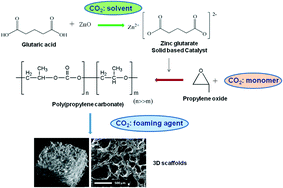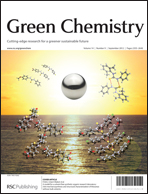The aim of this study was to develop an environmentally friendly process for the fabrication of three dimensional (3D) biomimetic scaffolds from biodegradable poly(propylene carbonate) (PPC). Prior to production of scaffolds, PPC was synthesized using a one-pot process in which the zinc glutarate catalyst was first fabricated in a supercritical CO2 system. The scaffolds were then prepared by gas foaming/salt leaching followed by aminolysis and layer-by-layer (LBL) gelatin assembly on the surface. The pore size and interconnectivity were controlled by the variation of gas foaming process parameters such as temperature, CO2 pressure, depressurization rate and particle size of salt (NaCl). The pore size was within the range of 116 ± 53 to 418 ± 84 μm and the porosity was between 69.8 and 92.3%. The results of micro-CT scan analysis demonstrated that porosity and pore interconnectivity were enhanced by increasing the pore size. However, the compressive modulus of hydrated scaffolds was decreased from 380 ± 90 to 200 ± 50 kPa, when the pore size was increased from 232 ± 91 to 411 ± 108 μm. The results of fluorescence microscopy demonstrated that gelatin was uniformly deposited on the 3D scaffolds. Surface modification of hydrophobic PPC scaffolds substantially increased the fibroblast cells attachment, penetration, and proliferation. The results of this study demonstrated the feasibility of eliminating toxic organic solvents in the synthesis of a solid based catalyst and processing PPC polymer into tissue scaffolds. The clean technology developed will be of great value for large scale production of biodegradable PPC that can be used for many purposes such as packaging products and plastic bags. In addition, it was shown that PPC can be considered as an alternative biomaterial for tissue engineering applications.

You have access to this article
 Please wait while we load your content...
Something went wrong. Try again?
Please wait while we load your content...
Something went wrong. Try again?


 Please wait while we load your content...
Please wait while we load your content...